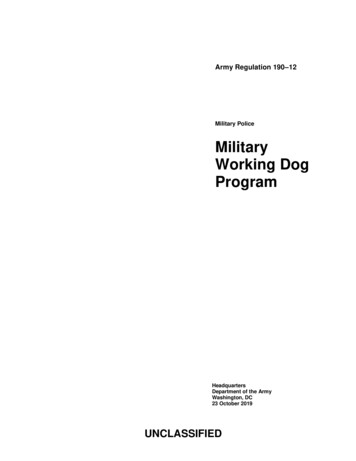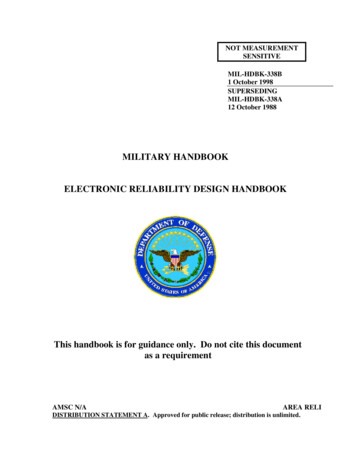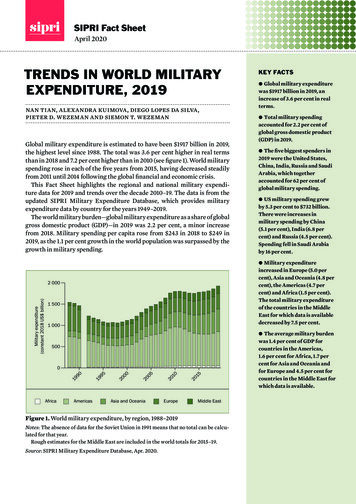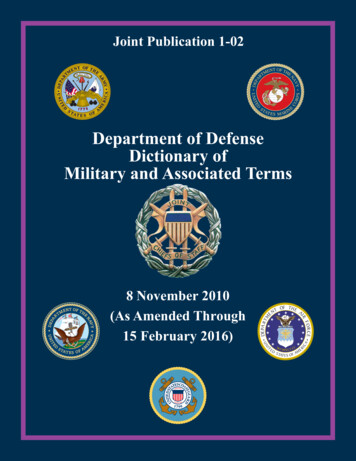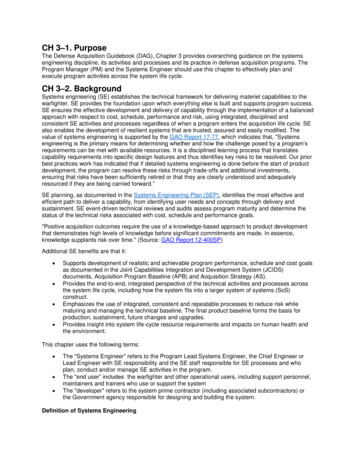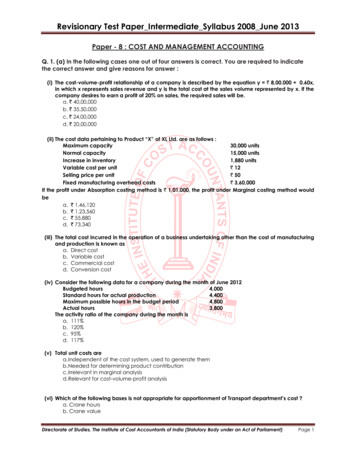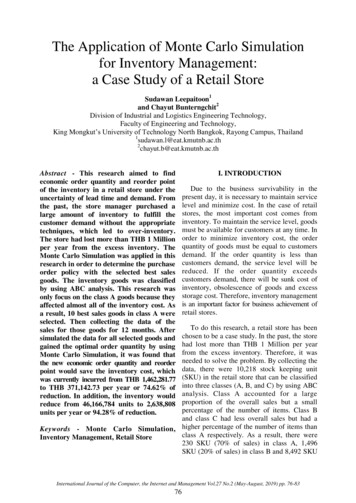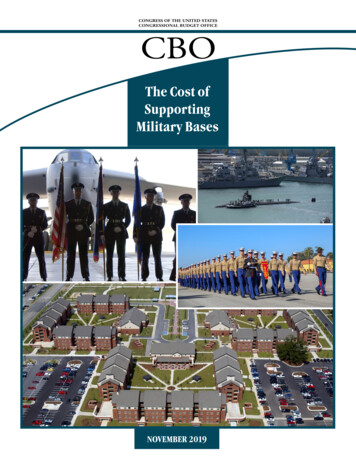
Transcription
CONGRESS OF THE UNITED STATESCONGRESSIONAL BUDGET OFFICEThe Cost ofSupportingMilitary BasesNOVEMBER 2019
At a GlanceThe Department of Defense operates hundreds of military bases and similarinstallations that host military units and support their daily operations, providing services such as housing, utilities, and grounds maintenance. This reportanalyzes the relationship between the cost of those services—also referred to asbase operations support (BOS)—and specific characteristics of a base, such asits population and physical size. The key findings of the Congressional BudgetOffice include the following: BOS costs are strongly related to the number of a base’s employees and itssquare footage of building space. With other base characteristics unchanged, BOS costs associated with anincrease in population were lower at larger bases than at smaller bases. Forexample, in 2016 BOS costs increased by 1,000 for each employee addedto bases with 25,000 or more employees, but they increased by 14,000 atbases with 5,000 or fewer employees. That finding implies that it would bemore cost-effective to expand the population at larger bases than at smallerones, everything else being equal. Other characteristics that affect BOS costs at a base are the branch ofservice that operates it, the mission of the units that it hosts, its location(inside or outside the United States), and its climate, although the effects ofthose characteristics are not as significant.www.cbo.gov/publication/55849
ContentsSummary1What Data Did CBO Use to Analyze the Cost of Base Operations Support?1What Did CBO Find?1What Are Some Limitations of CBO’s Analysis?1BOX 1. WHAT IS BASE OPERATIONS SUPPORT?2Background2Military Bases2DoD’s Budget and Its Spending on Base Operations Support3Bases CBO Analyzed4How CBO Analyzed Base Operations Support for Each Base5Characteristics CBO Analyzed5Characteristics CBO Did Not Analyze7Data and Sources7CBO’s FindingsHow a Base’s Size Related to Its Support Costs88How Additional Personnel and Building Space Correlated With BOS Costs10How Other Characteristics Related to BOS Costs10Possible Uses of CBO’s Results12BOX 2. PERSONNEL AND BUILDING SPACE REQUIREMENTS OF ARMY BRIGADE COMBAT TEAMS14Appendix A: CBO’s Statistical Model for Estimating the Costs of Base Operations Support17Appendix B: Estimated Change in Base Operations Support When Units MoveInside or Outside the United States21List of Tables and Figures25About This Document26
NotesThe years referred to in this report are federal fiscal years, which run from October 1 toSeptember 30 and are designated by the calendar year in which they end.All costs are expressed in 2019 dollars and are adjusted for inflation using the Bureau ofEconomic Analysis’s gross domestic product price index.Numbers in the text, tables, and figures may not add up to totals because of rounding.On the cover:Upper left: Base honor guard airmen stand in front of a B-52 Stratofortress at AndersenAir Force Base, Guam. U.S. Air Force photo by Staff Sergeant Bennie J. Davis III.Upper right: The Los Angeles-class fast-attack submarine USS Springfield makes itshomecoming arrival at Joint Base Pearl Harbor-Hickam, Hawaii. U.S. Navy photo byMass Communication Specialist 1st Class Michael Zingaro.Lower right: Marines from Fox Company, 2nd Recruit Training Battalion, march acrossthe parade deck during a graduation ceremony at Marine Corps Recruit Depot San Diego.Marine Corps photo by Lance Corporal Angelica I. Annastas.Bottom: Fort Bragg, North Carolina. Army Corps of Engineers photo by Jonas N. Jordan.Photo courtesy of the U.S. Army.
The Cost of SupportingMilitary BasesSummaryThe Department of Defense (DoD) operates hundreds ofbases that support the daily operations of units in the AirForce, Army, Marine Corps, and Navy, providing servicessuch as housing, utilities, and grounds maintenance,much as might be found in a town or city (see Box 1for a more detailed description of those services). In2016, 25 billion—about 4 percent of DoD’s budget—was allocated to the costs of such services, called baseoperations support (BOS). The costs of providing suchsupport vary between bases, and the factors that affectthose costs are not clearly understood. In this report, theCongressional Budget Office explores certain characteristics of bases, such as their size, geographic location, andthe mission of the units they serve, and uses statisticalmethods to assess the relationship between those characteristics and BOS costs.What Data Did CBO Use to Analyze the Cost of BaseOperations Support?CBO assembled 2016 data on more than 200 bases(about 90 percent of active-duty bases) in all fourservices. The characteristics CBO measured include thenumber of full-time DoD employees at a base, its building space, and its land area. Other characteristics CBOconsidered include the base’s location (in the UnitedStates or overseas), the branch of service running it, theprimary mission of the units it hosts, whether it hostsa significant number of transient personnel, the localclimate, and the local cost of living.What Did CBO Find?After analyzing all of the characteristics it identified,CBO found five that were clearly connected to a base’sBOS costs: its size, primary mission, branch of service,location, and the climate extremes that it experiences(including precipitation and temperature). Of the fivecharacteristics, the one most strongly related to BOScosts is size, in terms of both the number of employeesand the amount of building space a base has.CBO found that, with other characteristics unchanged,the increase in BOS costs associated with an increase inpopulation was smaller at larger bases than at smallerbases. For example, the average BOS costs associatedwith adding an employee at extremely large bases(25,000 or more employees) were 1,000; the corresponding increase in BOS costs at very small bases(5,000 or fewer employees) was 14,000. CBO alsofound that adding 1,000 square feet of building spacewas, on average, associated with an increase of about 4,000 in annual BOS costs, regardless of a base’s size.CBO’s results could be used to anticipate how BOS costswould change if units were relocated between bases,new units were added, or existing units were disbanded.Because CBO’s analysis suggests that BOS costs wouldincrease less if units were added to large bases ratherthan to smaller ones, relocating units from smaller basesto larger ones would reduce overall BOS costs in manycases. Conversely, relocating units from larger bases tosmaller ones would generally increase those costs, allother things being equal. (Creating a new unit and adding it to any base would, of course, increase overall BOScosts.)What Are Some Limitations of CBO’s Analysis?CBO’s analysis did not account for all base characteristics that were potentially relevant because sufficientdata for some characteristics were not available or weredifficult to measure. The omitted characteristics includethe number of family members on the base; the age ofbuildings and other infrastructure; the number and typeof BOS services; the intensity of operations (intensityis higher, for example, when units are mobilizing fordeployment); the portion of building space used forfamily housing (the cost to operate and maintain familyhousing is funded through a separate appropriation); andthe quality or standard of BOS services (higher standardsare expected to cost more).
2 The Cost of Supporting Military BasesNovember 2019Box 1 .What Is Base Operations Support?Military bases and similar installations are an important part ofthe support infrastructure that enables combat and noncombatunits to prepare for their missions. Although their physicalsize depends on the needs of the units they host, most basesprovide similar basic services, referred to as base operationssupport (BOS). BOS services are funded through the Department of Defense’s operation and maintenance appropriation.BOS services support troops in a number of ways: Facility Services. Services include those a city mightprovide to its citizens, such as operations and maintenanceof utility and sanitation systems, equipment maintenance,fire protection, crash rescue, custodial services, refusecollection and disposal, snow removal, street sweeping,grounds maintenance, and insect control. BOS services inthis category also include engineering services, leases ofreal property, security such as physical barriers and policeservices, environmental conservation, and pollution prevention programs. Personnel Support. These services support the daily lifeof service members and their families. They include diningfacilities, housing, religious services, education, counseling,child and youth development, and morale, welfare, andrecreational services.CBO’s analysis is based on the level of BOS services thatbases provide today. CBO did not address whether thecurrent level of services is optimal for ensuring readiness(the ability of service members to perform their mission)or retention (their continuation in military service). It ispossible that BOS services enhance readiness by contributing to unit training or retention of personnel. A basewith higher BOS costs may thus make a greater contribution to a unit’s readiness than a base with lower BOScosts. However, to CBO’s knowledge the link betweenthe level of BOS services offered and the readiness of aunit has not been measured.BackgroundDoD operates bases and other installations in all50 states and all U.S. territories, as well as in manyforeign countries.1 This section describes those bases,1. A base is a military base, camp, post, station, yard, center, homeport, or other location under DoD’s jurisdiction, including leasedspace, that is controlled by or primarily supports DoD’s activities. Mission Support. To support the operations of militaryunits they host, bases operate airfields, ports, and training ranges and provide other support to transient militaryaircraft and air crews. Administrative Services. This category of services sup-ports the staff and personnel management of the hostedmilitary units and other organizations on the base. Suchservices include public affairs, financial management, legal,contracting, and other administrative services. Other Support. Other services support workforce produc-tivity, the distribution of goods and personnel, and security.Such services include information technology, communications (such as telephone service), and logistics (supplyoperations and shuttle buses, for example).Long-term capital expenditures to sustain, restore, and modernize facilities at bases are not included in BOS costs and arefunded through a separate budget account. In addition, units’direct costs, such as the pay of military personnel and theoperation and maintenance of their weapon systems, are notincluded in BOS costs.the amount spent on their support services, and the dataCBO collected and analyzed.Military BasesIn 2016, the most recent year for which detailed figuresare available, DoD’s real estate portfolio covered about27 million acres, and its buildings occupied 2.3 billionsquare feet of space.2 Those buildings are used for avariety of functions, including housing, maintenance,supply, and training (see Figure 1). Military bases are thelargest share of DoD’s real estate portfolio.In constructing its database, CBO focused on activeduty bases because most DoD bases are in that categoryand detailed data are available for them. There were234 active-duty bases in 2017—168 in the United States2. See Department of Defense, Base Structure Report—Fiscal Year2018 Baseline, https://go.usa.gov/xpB6Z (PDF, 2.4 MB).
November 2019The Cost of Supporting Military BasesFigure 1 .Space Occupied by All of DoD’s Buildings, by Function, 2016Family Housing395Maintenance and Production311SupplyTroop Housingand Mess FacilitiesOperation and Training295276276Community Facilities262Administrative Facilities262Hospital and Medical FacilitiesResearch, Development,Test, and EvaluationUtility and GroundImprovementsDoD owns or leases 2.3 billionsquare feet of building space,which it uses for housing, medicalcare, and other functions.11382220100200Millions of Square Feet300400Source: Congressional Budget Office, using data provided by the Department of Defense.Data include buildings assigned to active-duty and reserve forces as well as buildings that have been privatized or are operated by private entities forDoD. A building is defined by DoD as a roofed and floored facility enclosed by exterior walls that protects people and property from direct effects ofweather such as rain, wind, or sun.DoD Department of Defense.and 66 overseas.3 The missions of the units and organizations hosted on those bases span the range of DoD’sactivities—they include administration, research anddevelopment, individual skills training, and air, ground,sea, and underwater combat.The Army, Navy, and Air Force each operate about70 active-duty bases, and the Marine Corps operates23 (see Figure 2). Most of the Army’s overseas bases arein Germany and other European countries. The Navy’sand Marine Corps’ overseas bases are mostly located inJapan and South Korea. Most of the Air Force’s overseasbases are in Germany, Japan, and South Korea.DoD’s Budget and Its Spending onBase Operations SupportDuring the past two decades, DoD’s total budget andBOS costs for the military’s service branches rose and fellin tandem even as the number of active-duty personnel3. The number and location of those bases change little from year toyear. Some were not included in CBO’s analysis because completedata were not available for them.declined.4 Adjusted for inflation, DoD’s budget almostdoubled between 2000 and 2010, to 195 percent of its2000 budget, before declining to 153 percent of the2000 budget in 2017 (see Figure 3).5 Similarly, BOScosts for the military’s service branches grew by 150 percent from 2000 to 2010, before declining by 2017 to120 percent of the 2000 figure.6By contrast, the number of active-duty personnel hasvaried much less. It grew relatively slowly through 20104. DoD refers to the number of active-duty military personnel onSeptember 30, the last day of the fiscal year, as end strength.5. Office of the Under Secretary of Defense (Comptroller),Operation and Maintenance Overview, Fiscal Year 2019 BudgetEstimates, exhibit O-1 (March 2018), and Overview - FY 2019Defense Budget, United States Department of Defense Fiscal Year2019 Budget Request (February 2018), both available at https://go.usa.gov/xpB6N. Those BOS costs exclude roughly 1 billionin spending managed by the Defense Health Program. DoD’sbudget includes funding for overseas contingency operations(OCO).6. BOS costs also include OCO funding. BOS costs shrank as apercentage of DoD’s budget from 2000 to 2010, in part becausesubstantial amounts of OCO funding were included in DoD’sbudget and little of that funding was for BOS costs.3
4 The Cost of Supporting Military BasesNovember 2019Figure 2 .Number of Active-Duty Bases, by Service andLocation, 2017Each service branch of the U.S. Armed Forces operates bases in theUnited States and other countries. The Army and Navy have the largestshare of overseas bases.Number of Bases8060Overseas40In total, the bases in CBO’s database accounted for 17.4 billion (in 2019 dollars) in annual BOS costs,2.1 million employees, 1.7 billion square feet of buildings; and 18 million acres (see Table 1).8United States200Air ForceArmyMarine CorpsBases CBO AnalyzedTo conduct its analysis, CBO compiled data on funding,size, population, and other characteristics for a sampleof 203 individual bases (representing about 90 percentof active-duty bases).7 Those base-level data are moresuitable for a detailed analysis of BOS costs than theconsolidated summary of BOS funding for all bases thateach military service usually provides to the Congress.CBO’s database, described in more detail in the nextsection of this report, contains information for 2016, themost recent year for which complete information wasavailable.NavySource: Congressional Budget Office, using data provided by theDepartment of Defense.Bases that DoD designates as joint bases are included with the serviceresponsible for managing them.A base is a military base, camp, post, station, yard, center, home port, orother location under DoD’s jurisdiction, including leased space, that iscontrolled by or primarily supports DoD’s activities.DoD Department of Defense.and then declined. (The number of active-duty personnelgrew by 3 percent from 2000 to 2010 as the Army andMarine Corps added military personnel for the wars inIraq and Afghanistan; however, all services shed personnel in the ensuing years so that, by 2017, the number ofpersonnel was 94 percent of what it had been in 2000.)Those trends suggest that DoD allocates its BOS budgeton the basis of factors that are not directly related to thenumber of personnel: Independent of the overall sizeof the military force, DoD spends more on BOS whenits budget is larger, and less on BOS when its budget issmaller. This report does not look at how total costs forBOS vary over time in relation to DoD’s overall budget,but at how the cost of providing daily services at a basein any one year varies with certain characteristics of thatbase, such as the total number of personnel and thebase’s location.The Air Force had the largest number of bases in CBO’ssample (66 bases, or 33 percent of the total), followed bythe Navy (57 bases, 28 percent of the total), Army (52bases, 26 percent), Marine Corps (16 bases, 8 percent),and joint bases (12 bases, 6 percent). 9 (See Table 2.)The average characteristics of each service’s bases differin a number of respects. For example, the number ofemployees at Air Force bases averaged 7,000, and thenumber of employees at Navy, Army, Marine Corps, andjoint bases averaged 8,000, 13,000, 12,000, and 23,000,respectively.There are also significant variations between the baseswithin each service. For instance, Air Force bases rangein size from Arnold Air Force Base, a research anddevelopment base with about 500 military and civilian employees, to Nellis Air Force Base, an aviationcombat training base with about 13,000 employees.Similarly, Navy bases in CBO’s database range fromNaval Weapons Station Earle, which handles ammunition and has about 700 employees, to Naval Station7. That sample consists of bases for which sufficient informationwas available.8. The 17.4 billion represents about 70 percent of DoD’s 25 billion BOS funding in 2016. The bases and smaller sitesexcluded from CBO’s database account for the remaining 7.6 billion in BOS funding that year.9. Joint bases are used by multiple military services and hosted byone service. They are consolidations of separate bases next to ornear each other that were formerly operated by different services.Because of their unique nature, CBO grouped joint bases in theirown distinct category.
November 2019The Cost of Supporting Military BasesFigure 3 .Growth Since 2000 in BOS Costs, DoD’s Budget, and the Number of Active-Duty PersonnelIndex, 2000 13.02.52.0DoD’s Budget 411 BillionBOS Costs 19 BillionActive-Duty Personnel 1,384,030 799 Billion 28 Billion1.51,425,2151.0Total DoDBudgetBOS costs have correlatedmore closely with the amount 629 Billion of DoD’s budget over thepast two decades than with 23 Billionthe number of active-duty1,300,482 personnel.BOS 82010201220142016Source: Congressional Budget Office, using data provided by the Department of Defense.Dollar amounts are in 2019 dollars.A base is a military base, camp, post, station, yard, center, home port, or other location under DoD’s jurisdiction, including leased space, that iscontrolled by or primarily supports DoD’s activities.BOS costs cover only bases operated by the military’s service branches, including joint installations.Nearly all BOS costs are in DoD’s base budget. Overseas contingency operations, which are not in the base budget, contribute a negligible share offunding to those costs. (However, DoD’s total budget included substantial amounts of that funding during the period shown.)Active-duty personnel is the number of active-duty service members on the last day of a fiscal year, also known as end strength.BOS base operations support; DoD Department of Defense.Norfolk, home port to several Navy warships, with about65,000 employees.How CBO Analyzed Base Operations Supportfor Each BaseBecause DoD does not routinely provide a detailed breakdown of BOS costs for individual bases, CBO collecteddata on operating costs and characteristics for 203 basesfrom a number of sources to create a database of characteristics that might affect the cost of each base’s operationssupport. The agency then used statistical techniques toexplore how particular characteristics of each base, such asits size or geographic location, related to its BOS costs.Characteristics CBO AnalyzedCBO calculated the independent relationships between anumber of base characteristics and BOS costs at bases.1010. For an example of previous research in this vein, see Joseph G.Bolten, John Halliday, and Edward G. Keating, Understandingand Reducing the Costs of FORSCOM Installations (RANDThe agency examined a number of factors, among themthe base’s size, mission, climate, and location; the branchof service running the base; the number of transient personnel; and the cost of living. CBO’s analysis does notestablish cause and effect—that is, it does not indicatethat a particular base characteristic caused changes inBOS costs.Size. The primary measure of size in CBO’s analysis isthe number of employees living or working on a base.CBO also looked at other measures of size, including abase’s land area and the square footage of its buildings,for each base.11Corporation, 1996), www.rand.org/pubs/monograph reports/MR730.html.11. Building space includes square footage in buildings owned orleased by the federal government, as well as federal buildings thatfall in neither of those categories. Acreage includes governmentowned land, public land, public land withdrawn for military use,licensed and permitted land, and foreign land used by DoD.5
6The Cost of Supporting Military BasesNovember 2019Table 1 .Average Size of the Bases CBO AnalyzedAverageper BaseAverageper Employee8610,17080.10.008n.a.0.00080.00001Annual BOS Costs (Millions of 2019 dollars)Number of Military and Civilian EmployeesaBuilding Space (Millions of square feet)bLand Area (Millions of acres)cTotal in Data Sample(203 bases)17,3742,064,4181,65118Source: Congressional Budget Office, using data provided by the Department of Defense.A base is a military base, camp, post, station, yard, center, home port, or other location under DoD’s jurisdiction, including leased space, that iscontrolled by or primarily supports DoD’s activities.BOS base operations support; DoD Department of Defense.a. Excludes family members, contractors, and others who are not direct employees of the Department of Defense.b. Includes all federal buildings on a base, including those leased by the federal government.c. Includes land owned or used by the federal government. Does not include land area of bases located outside the United States because thatacreage is not enumerated in DoD’s Base Structure Report.Table 2 .Size of the Bases CBO Analyzed, by Branch of ServiceAverage per BaseNumber of MilitaryBOS Fundingand Civilianin 2016Employeesa(Millions of dollars)Air ForceNavyArmyMarine CorpsJointAll DoD7,0008,00013,00012,00023,00010,000All BasesBuilding Space(Millions of square feet)b685512110215386Land Area(Thousandsof centage of Total33282686100Source: Congressional Budget Office, using data provided by the Department of Defense.Dollar amounts are in 2019 dollars.A base is a military base, camp, post, station, yard, center, home port, or other location under DoD’s jurisdiction, including leased space, that iscontrolled by or primarily supports DoD’s activities.BOS base operations support; DoD Department of Defense.a. Excludes family members, contractors, and others who are not direct employees of the Department of Defense.b. Includes all federal buildings on a base, including those leased by the federal government.c. Includes land owned or used by the federal government. Does not include land area of bases located outside the United States because thatacreage in not enumerated in DoD’s Base Structure Report.Branch of Service. CBO’s analysis took into accountwhether a base is owned by the Air Force, Army, MarineCorps, or Navy or is operated as a joint base.Mission. Many of the activities and equipment on a basereflect the primary mission of units hosted there. Forexample, bases hosting aviation units have runways andthose hosting ground combat units often have large areasfor training. To assess how mission is associated withBOS costs, CBO considered base type: aviation, ground,
November 2019logistics, research and development, naval, space-related,training, or other.12Location. Some U.S. military bases are located in foreigncountries with high costs of living. Long shipping distances could also contribute to high BOS costs at thosebases. However, some of those bases receive supportfrom the host nation, reducing the costs borne by theU.S. military. CBO’s analysis considers whether a base islocated inside or outside the United States.Share of Transient Personnel. The base populationdata available to CBO exclude personnel who are at thebase for less than six months. To account for the possible effect of such transient personnel on BOS costs,CBO used an indicator to designate bases that have afew thousand or more transient personnel a year. CBOobtained that information from discussions with DoDofficials and a review of DoD websites that providedetails about missions and current activities on bases.Bases that were identified as having many transient personnel include those that provide training as a primarymission and those that host other individual or unittraining programs.Climate Extremes. Extreme temperatures and largeamounts of precipitation affect BOS costs by requiringabove-average expenditures for such services as snowremoval in cold climates (particularly on bases withrunways) or upkeep of cooling systems in hot climates.Using information on world climate zones, CBO constructed an indicator for bases in arctic or hot climates toaccount for the effect of such climates on BOS costs.13Cost of Living. Bases in locations DoD designates ashaving a high cost of living were designated as such inCBO’s analysis.Appendix A discusses CBO’s analytical approach ingreater detail.12. The “other” category includes bases that host units andorganizations that provide administrative and miscellaneoussupport.13. Common climate-zone demarcations include polar or arctic,temperate, arid, tropical, Mediterranean, and mountainouscategories. CBO created the indicator using long-termtemperature and other climate-related information obtainedfrom the National Oceanic and Atmospheric Administration. See“Data Snapshots: Reusable Climate Maps” (accessed February 5,2019), www.climate.gov/maps-data.The Cost of Supporting Military BasesCharacteristics CBO Did Not AnalyzeThe characteristics included in CBO’s analysis explainabout 75 percent of the observed differences in BOScosts between bases. The unexplained portion could beattributed, in part, to characteristics that CBO’s analysisomitted because sufficient data were not available. Theomitted characteristics include: Other Populations. In addition to employees, familymembers, veterans, and members of the public usethe base’s services. Age of Infrastructure. Older buildings andinfrastructure may incur higher BOS costs. Types of Services. The mix of services such aschild care, lodging, meals, family counseling, andrecreation affects BOS costs. Most bases provide asimilar mix of such services. Intensity of Operations. A high pace of operations,such as during mobilizations for deployment, couldincrease BOS costs. Family Housing. DoD uses a separate budgetappropriation for family housing that covers the costof operating the housing. Quality of Services. Service standards such as thefrequency of grounds maintenance may vary betweenbases. Differences in those standards could affect BOScosts.Data and SourcesCBO went to a variety of sources to obtain informationon each base’s funding, physical size, population, andother relevant features that might potentially affect costs.Funding. CBO obtained figures for BOS funding ateach base from budget officials at its service headquarters. CBO adjusted the data provided by the services tomore closely reflect BOS activities at certain bases. Forexample, it is not uncommon for a unit from one serviceto be located on another service’s base. When the parentservice allocated BOS funds for such units (usually relatively large ones), CBO added that amount to the hostbase’s BOS funds.14 In another example, bases that DoD14. For example, CBO allocated to Marine Corps Base Quanticothe amount of BOS funds the Army paid it to maintain the U.S.Army Criminal Investigation Command there.7
8 The Cost of Supporting Military Basesdesignates as joint bases sometimes are actually separatebases that do not adjoin each other. When such baseswere separately allocated BOS funds by their parentservices, CBO combined those amounts under the corresponding joint designation.15Physical Size. DoD publishes an annual Base StructureReport (BSR) that provides a fiscal year-end snapshotof the department’s real property inventory.16 TheBSR lists individual sites—defined as those that have aspecific geographic location with individual land parcelsor facilities—that are larger than 10 acres and have areplacement value of more than 10 million. The reportincludes infor
climate, and the local cost of living. What Did CBO Find? After analyzing all of the characteristics it identified, CBO found five that were clearly connected to a base’s BOS costs: its size, primary mission, branch of service, location, and the climate extremes that it experienc


